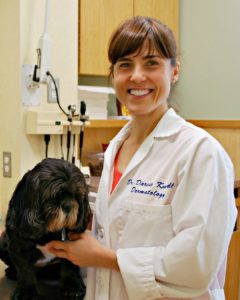At this time of year we are all enjoying spring and looking forward to the summer. But with leafy trees, colorful flowers, and plants blooming, we are also very aware of the pollens!
Many humans suffer from allergic disease and many pet owners can see their dogs and cats suffering as well. Cats and dogs develop allergies to the same things as humans – pollens, dust mites, molds – but their symptoms tend to manifest in slightly different and sometimes unexpected ways. Cats and dogs might have eye discharge, a stuffy/runny nose, or coughing but the most common symptoms are itchy, inflamed skin. Although scratching is observed, most dogs and cats lick to take care of the sensation of itch. But they are very creative – they will army crawl (rubbing their abdomen on a rough surface), flip on their backs and wiggle around, use the bottom of a chair or table to take care of a hard to reach spot. They will also rub their muzzle or ears against the couch. If you observe your dog or cat chewing their limbs, nibbling on their paw webbing, or you notice patches of your pet’s hair are suddenly missing, your pet may be itchier than you think.
Allergies can also manifest as bacterial skin infections or recurrent ear infections too.
There are three big categories of allergies for dogs and cats – flea/insect allergy, food allergy, and environmental allergy (atopic dermatitis). These categories can also overlap in a single patient.
As board-certified dermatologists, Dr. Darcie Kunder and Dr. Lindsey Citron, have studied allergic skin disease in pets extensively. They love talking about treatments for active allergy flares as well as management and prevention strategies for their patients. Allergies are not curable but they are certainly treatable. “We especially love seeing younger patients,” says Dr. Kunder. “It is common for allergy symptoms to progress as a patient ages, so starting treatment when a patient is young can be so rewarding – we can put some roadblocks in place to help manage symptoms over the lifetime of the patient.”
Dr. Citron notes that “Allergic disease is dynamic and individualized. Each patient has a unique allergic syndrome (ear disease, paw inflammation, intense itchiness, development of hives, asthma/airway disease) – these syndromes are subject to evolve with each patient.” One simple treatment strategy involves regular bathing – this helps remove allergens from the pet’s hair as well as cut down on surface bacteria and yeast that can cause secondary infections. For pets that don’t enjoy baths or for living situations that prevent routine bathing, wipes or leave-on sprays can clean and provide medications that remain on the skin for a good residual effect.
Skin barrier boosters like vitamin E and omega fatty acids can also help. Allergies are essentially a skin barrier problem so anything we can do to boost the barrier will help with symptoms over the long-term.
Understanding your pet’s allergies and seeking the right help can significantly improve their quality of life. If you notice signs of allergies in your pet—whether it’s persistent itching, gastrointestinal issues, or respiratory symptoms—don’t hesitate to reach out to your veterinarian. If needed, they will refer you to a veterinary dermatologist who can provide specialized care tailored to your pet’s specific needs. For more information or to schedule a consultation with Friendship’s Dermatologists, visit our department page or contact us at 202.363.7300. Your pets deserve the best, and understanding their health is the first step toward ensuring their happiness and comfort.

Dr. Darcie Kunder is a Diplomate of the American College of Veterinary Dermatology. She graduated from the University of Pittsburgh, where she majored in Poetry Writing. She attended veterinary school at the University of Pennsylvania School of Veterinary Medicine before completing a 1-year Small Animal internship in Connecticut and a 1-year Specialty internship in Dermatology at the University of Wisconsin Veterinary Medical Teaching Hospital, followed by a 3-year dermatology residency program at the University of Pennsylvania School of Veterinary Medicine .
